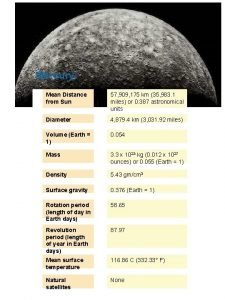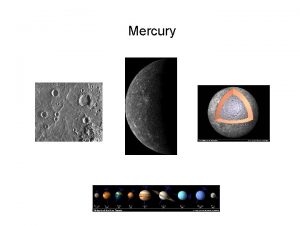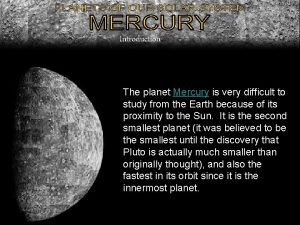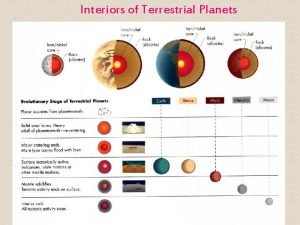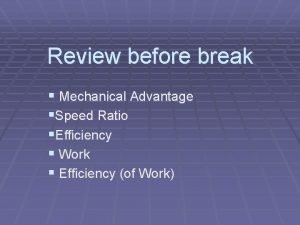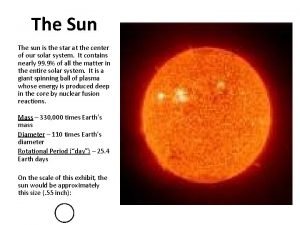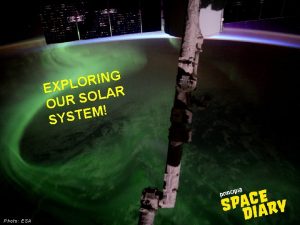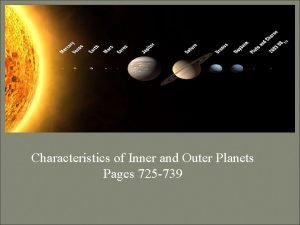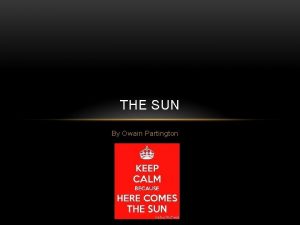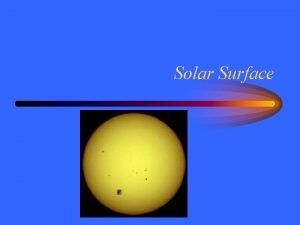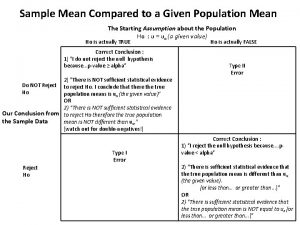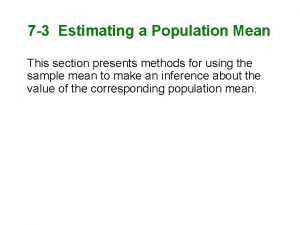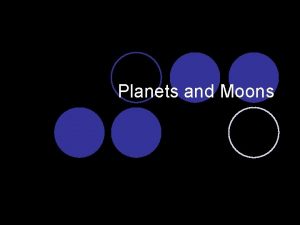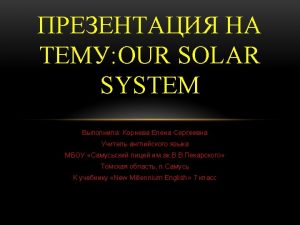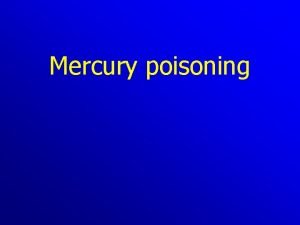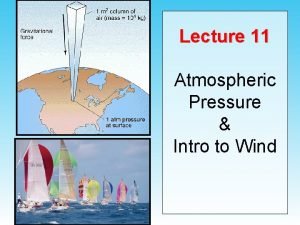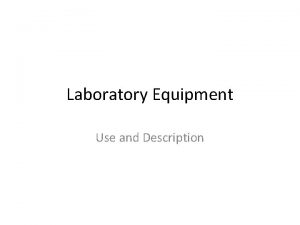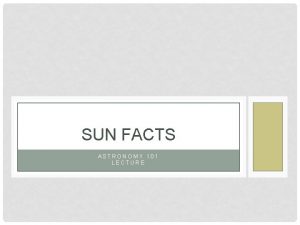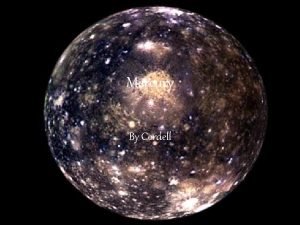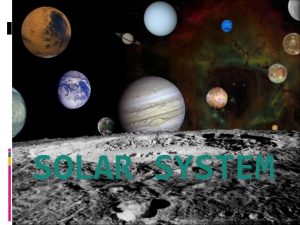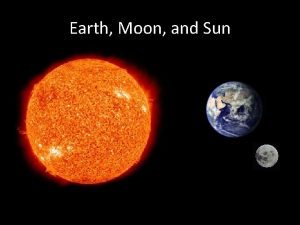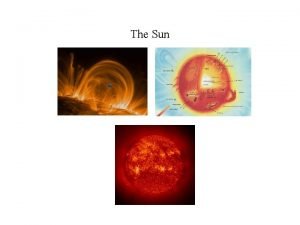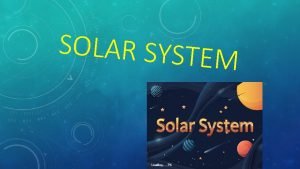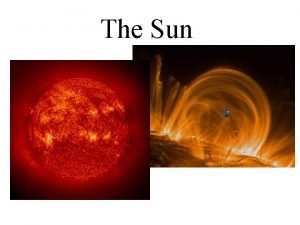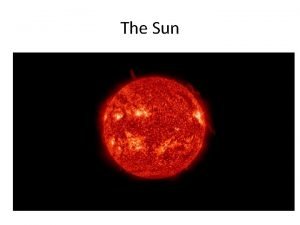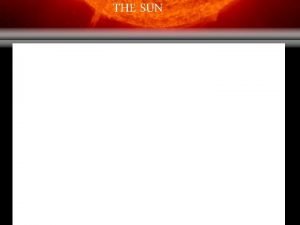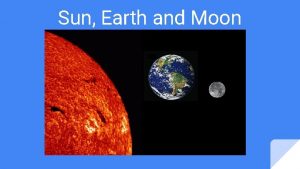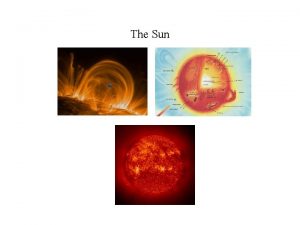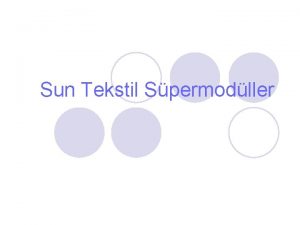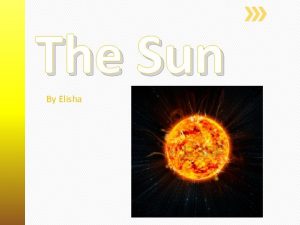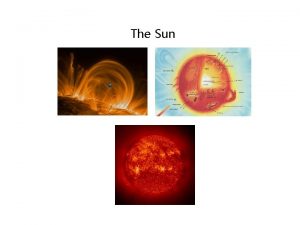Mercury Mercury Facts Mean distance from Sun 0




































- Slides: 36

Mercury

Mercury Facts Mean distance from Sun: 0. 3871 AU (57, 910, 000 km/35, 980, 000 mi) Length of Year: 88 days Rotation period: 58. 65 days Mean orbital velocity: 48 km/s (30 mi/s) Inclination of axis: 2° Average temperature: 800° F (427° C) day -300° F (-183° C) night Diameter: 4, 878 km (3, 031 mi) Number of observed satellites: 0 Magnetic field weak

Historical • Mercury is one of the five planets known to the ancients. They called these planets "wandering stars". • Mercury may be seen as an evening "star" near where the sun has set, or as a morning "star" near where the sun will rise. • The ancient Greeks called the evening star Hermes and the morning star Apollo, believing them to be different objects. • The planet is named for Mercury, the Roman messenger of the gods.

Mercury is not much bigger than our Moon. Of the nine planets orbiting the Sun, only Pluto is smaller. It is so close to the Sun that it can be seen only in the twilight sky of the Earth. The hazy atmosphere near the horizon on Earth spoils the view of Mercury for ground-based telescopes. Earth-based telescopic photo of Mercury taken from Catalina Observatory 1. 5 meter (61 inch) telescope.

Mercury Orbital Facts Until 1965, scientists thought that the same side of Mercury always faced the Sun. Mercury takes only 88 Earth days to complete one orbit, but it rotates slowly about its own axis, only once every 59 Earth days. This means that it rotates precisely three times for every two orbits, known as a 3: 2 orbital resonance.

More Orbital Facts… It orbits the Sun in a highly elliptical orbit at about one third of the Sun-Earth distance. Only the orbit of Pluto, the outermost planet, is more elliptical. At perihelion (closest approach to the Sun), it is only 46 million kilometers from the Sun, but at aphelion (furthest approach) it is 70 million kilometers away. The axis of rotation is almost perpendicular to the orbital plane, so Mercury does not have opposite seasons in each hemisphere, as Earth has. Instead, the temperature at the equator varies as the planet's distance from the Sun changes during its elliptical orbit. The maximum temperature is 700 K (427 o. C), but the minimum only 90 K (-183 o. C). Mercury has very little atmosphere so the surface cools down rapidly on the night side.

Transit of Mercury Visible from Earth about every 8 years.

Image of May 7, 2003 Mercury Transit was taken by NASA/ESA's SOHO (Solar & Heliospheric Observatory)

Transit of Mercury on November 8, 2006. Sunspot #923, which is just below the equator at the left-hand side, is much bigger than Mercury is. Two more sunspots at the righthand side at the equator. Mercury appears as a small black dot in the lower middle of the solar disk.

Next transit: May 9, 2016

Mariner 10 3 Flybys 1974 -1975 Mariner 10 was the seventh successful launch in the Mariner spacecraft series, and the first to use the gravitational pull of one planet (Venus) to reach another (Mercury). Instruments on board the spacecraft were designed to measure the atmospheric, surface, and physical characteristics of Mercury and Venus. Experiments included television photography, magnetic field, plasma, infrared radiometry, ultraviolet spectroscopy, and radio science detectors. An experimental X-band, high-frequency transmitter was flown for the first time on the spacecraft. 10, 000 pictures with 57% planet coverage reveal an intensely cratered, Moonlike surface and a faint atmosphere of mostly helium, resulting from solar wind bombardment.

Incoming View of Mercury This photomosaic of Mercury was constructed from photos taken by Mariner 10 six hours before the spacecraft flew past the planet on March 29, 1974. These images were taken from a distance of 5, 380, 000 kilometers (3, 340, 000 miles).

Close Encounter This two-image mosaic of Mercury was constructed from photos taken by Mariner a few hours before the spacecraft's closest and first encounter with the planet on March 29, 1974.

Outgoing View of Mercury This mosaic of Mercury was created from more than 140 images taken by the Mariner 10 spacecraft on March 29, 1974. The images were acquired after the spacecraft exited Mercury's shadow.

Mercury’s Atmosphere Like the Earth’s Moon, Mercury has a very volatile atmosphere. What little atmosphere exists is made up of atoms or ions blasted off its surface by the solar wind and has less than a million-billionths the pressure of Earth's atmosphere at sea level. It is composed chiefly of oxygen, sodium, and helium. Mercury's extreme surface temperature enhances the escape of these volatile atoms into space. With no atmosphere or hydrosphere, there has been no erosion from wind or water. Mercury may have water ice at its north and south poles. The ice exists inside deep craters. The floors of these craters remain in perpetual shadow, so the Sun cannot melt the ice. Meteorites do not burn up due to friction as they do in other planetary atmospheres.

Mercury’s Surface Highly cratered with smooth terrains. Relatively ancient, volcanic surface. Similar to Earth’s Moon, but fewer craters and more “plains”. Geologically longer active than Moon? Plains mostly lava or impact ejecta?

Caloris Basin Largest structure on Mercury ~1300 km Asteroid-size impactor early in solar system history Basin contains smooth plains but is highly ridged and fractured.

Antipodal from Caloris "Weird terrain“, hilly, lineated region. The shock wave produced by the Caloris impact was reflected and focused to this antipodal point, thus jumbling the crust and breaking it into a series of complex blocks. The area covered is about 100 kilometers (62 miles) on a side.

Discovery Rupes Sinuous feature may be a thrust fault. This feature and many similar ones on Mercury suggest compressional forces and 1 -2 km radial shrinkage planet-wide. 200 km Cooling, contraction od Mercury at end of volcanically active early history?

Mercury’s Interior Mercury’s density is similar to Earth’s, but planet is only ~1/3 the size of Earth. Large iron core, 75% of radius (~1850 km), Silicate mantle only ~550 km thick.

Origin of Mercury’s Large Core Unknown, but hypotheses include: 1. Radial compositional (iron) zonation of the inner solar system. 2. Young Mercury was a larger planet, but giant impact removed much of mantle.

Messenger Discovery Mission MErcury Surface, Space ENvironment, GEochemistry, and Ranging mission. MESSENGER will enter Mercury orbit in March 2011 and carry out comprehensive measurements for one Earth year. $286 million total mission cost

Principal Investigator: Dr. Sean C. Solomon Carnegie Inst. of Washington Project Management: Johns Hopkins University Applied Physics Laboratory Instruments: JHU/APL, GSFC, Univ. Colorado, Univ. Michigan Structure: Composite Optics, Inc. Propulsion: Gen. Corp Aerojet Navigation: Jet Propulsion Laboratory

Messenger Mission Summary Launch dates: August 3, 2004 Launch Vehicle: Delta II 7925 H Earth flyby (1) August 2005 Venus flybys (2): 2006, 2007 Mercury flybys (3): 2008, 2009 Mercury orbit: March 2011


Figure 2. MESSENGER mission timeline featuring major trajectory adjustments (DSM dates may change)

Science Payload

Messenger “Science Drivers”: • What planetary formation processes led to the high metal/silicate ratio in Mercury? • What is the geological history of Mercury? • What is the nature and origin of Mercury's magnetic field? • What is the structure and state of Mercury's core? • What are the radar-reflective materials at Mercury's poles? • What are the important volatile species and their sources and sinks on and near Mercury?

MESSENGER’s WAC multi-spectral images to study compositional variations across the surface of Mercury. The white arrows identify areas of Mercury’s surface that are interpreted to be relatively young volcanic plains, and the black arrows point to reddish areas interpreted to be volcanoes. Most of the color differences studied here are believed to indicate variations in the mineral composition and physical state of the rocks at different places on Mercury.


Capturing Mercury through MESSENGER's Dual Cameras Date Acquired: September 29, 2009 Image Mission Elapsed Time (MET): 162709161, 162709202 Instrument: Narrow Angle Camera (NAC) and Wide Angle Camera (WAC) of the Mercury Dual Imaging System (MDIS) Resolution: Top WAC image: 24. 5 kilometers/pixel (15. 2 miles/pixel). Bottom NAC image: 3. 5 kilometers/pixel (2. 2 miles/pixel). Scale: Mercury's diameter is 4880 kilometers (3030 miles) Spacecraft Altitude: 137, 000 kilometers (85, 000 miles)


Rupes, Every Where Giant scarps (cliffs), called rupes, are believed to have formed when Mercury’s interior cooled and the entire planet shrank slightly as a result. This figure, recently published in Science magazine, shows one of these scarps (white arrows) that is about 270 kilometers (170 miles) long.


Date Acquired: September 29, 2009 Image Mission Elapsed Time (MET): 162744001 Instrument: Narrow Angle Camera (NAC) of the Mercury Dual Imaging System (MDIS) Resolution: 410 meters/pixel (0. 25 miles/pixel) in the lower right corner of this image Scale: This image is about 420 kilometers (260 miles) across Spacecraft Altitude: 16, 200 kilometers (10, 100 miles)

Bepi. Columbo ESA-ISAS Mission to Mercury Launched 2018, 1 Lander and 2 Orbiters Will start working 2025 The mission is named in honor of Giuseppe (Bepi) Columbo, an Italian scientist who explained Mercury's unusual rotation (three turns for every two trips around the Sun). He also suggested to NASA the way to make multiple fly-bys of Mercury during the Mariner 10 mission.
 Mean distance from the sun
Mean distance from the sun How far is mercury from the sun
How far is mercury from the sun Introduction of mercury
Introduction of mercury Mercury mean radius
Mercury mean radius The ratio of input distance to output distance
The ratio of input distance to output distance Distance vs displacement
Distance vs displacement Uranus distance from sun
Uranus distance from sun Uranus distance from sun
Uranus distance from sun Outer planets characteristics
Outer planets characteristics Facts about the sun
Facts about the sun Chromosphere facts
Chromosphere facts 64:8+9:9-63:7
64:8+9:9-63:7 What does the sun still rises in the same sky mean
What does the sun still rises in the same sky mean The sun still rises in the same sky
The sun still rises in the same sky What does make hay while the sun shines mean
What does make hay while the sun shines mean What does make hay while the sun shines mean
What does make hay while the sun shines mean Difference between sample mean and population mean
Difference between sample mean and population mean Mad mean absolute deviation formula
Mad mean absolute deviation formula If σm = 4 and n = 36, then σ =:
If σm = 4 and n = 36, then σ =: How to calculate point estimate
How to calculate point estimate Mean of the sampling distribution of the sample mean
Mean of the sampling distribution of the sample mean What does mean mean
What does mean mean Mean deviation from mean
Mean deviation from mean Says means matters
Says means matters Advantages and disadvantages of diaphragm cell process
Advantages and disadvantages of diaphragm cell process Mercury substitute in thermometers
Mercury substitute in thermometers Dropping mercury electrode diagram
Dropping mercury electrode diagram Special features of saturn
Special features of saturn Diameter of mercury in km
Diameter of mercury in km Mercury poisoning symptoms
Mercury poisoning symptoms Where does mercury come from
Where does mercury come from Mercury in fish
Mercury in fish Example of pressure
Example of pressure Classification of lamps
Classification of lamps Alcohol thermometer vs mercury thermometer
Alcohol thermometer vs mercury thermometer Terry giddings wikipedia
Terry giddings wikipedia Drop mercury electrode
Drop mercury electrode
